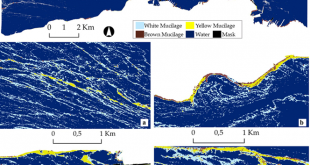Volume 112, May 2020, 106173
Soil salinity analysis of Urmia Lake Basin using Landsat-8 OLI and Sentinel-2A based spectral indices and electrical conductivity measurements
T. Gorji, A. Yildirim, N. Hamzehpour, A. Tanik, E. Sertel
Abstract: Soil salinization is one of the significant soil degradation problems especially faced in arid and semi-arid regions of the world. It poses a high threat to soil productivity in agricultural lands. The demand for economic and rapid detection and temporal monitoring of soil salinity has been rising recently. Satellite imagery and remote sensing approaches are the significant tools for accurate prediction and mapping of soil salinity in various regions of the world. This study aims to compare Landsat- 8 OLI and Sentinel-2A derived soil salinity maps of the western part of Urmia Lake in Iran by applying three different salinity indices in conjunction with field measurements. Totally 70 soil samples were collected from top 20 cm of surface soil in October 2016 from an area of 18 km2. Landsat-8 OLI and Sentinel-2A images were acquired in the same month; both images were atmospherically and radiometrically corrected prior to applying soil salinity indices. After comparing Normalized Difference Vegetation Index (NDVI) value of corresponding pixel for each sample with its electrical conductivity (EC) value, 54 soil samples with various EC ranges were selected for mapping. Among them, 42 samples were used for establishing the regression model and remaining 12 samples were utilized to validate the model. Multiple and linear regression analyses were conducted to correlate the EC data with their corresponding soil salinity spectral index values derived from visible bands of satellite images. The results revealed that soil salinity indices extracted from both Landsat-8 OLI and Sentinel-2A visible bands estimated soil salinity with acceptable accuracy of R2 0.73 and 0.74, respectively. Multiple linear regression analysis using both Landsat- 8 OLI and Sentinel-2A data demonstrated higher accuracy with R2 value of 0.77 and 0.75, respectively, compared to linear regression. This study proves that various soil salinity classes with different EC ranges can be estimated by correlating ground measurement data with satellite data.

Available Online: https://www.sciencedirect.com/science/article/pii/S1470160X20301102
 UHUZAM İTÜ – Uydu Haberleşme ve Uzaktan Algılama UYG-AR Merkezi
UHUZAM İTÜ – Uydu Haberleşme ve Uzaktan Algılama UYG-AR Merkezi 